The AMD Llano Notebook Review: Competing in the Mobile Market
by Jarred Walton & Anand Lal Shimpi on June 14, 2011 12:01 AM ESTApplications, Round Two: Treading Water
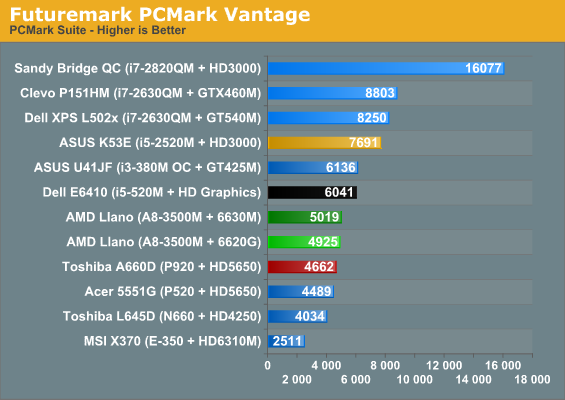
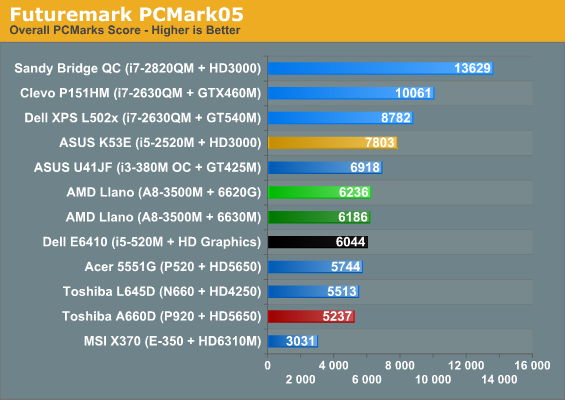
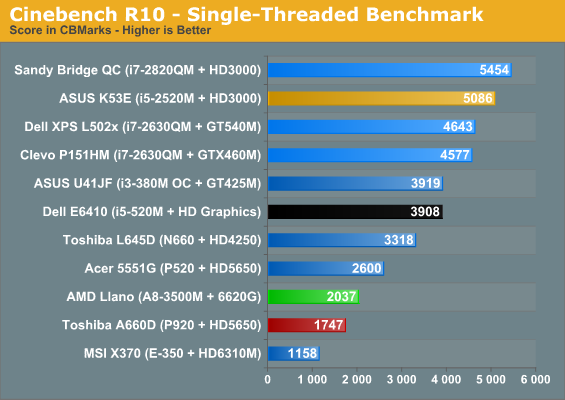

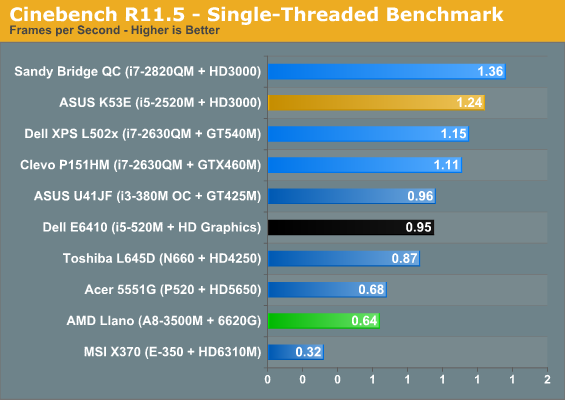
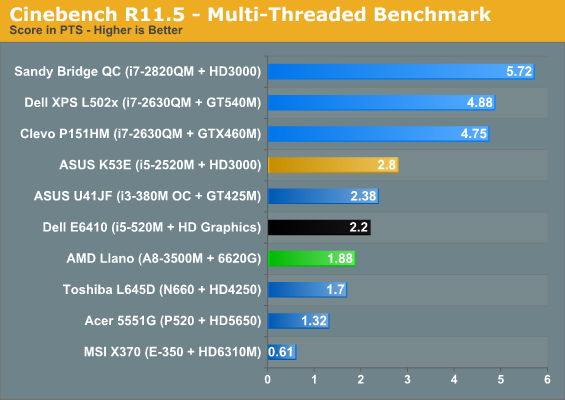
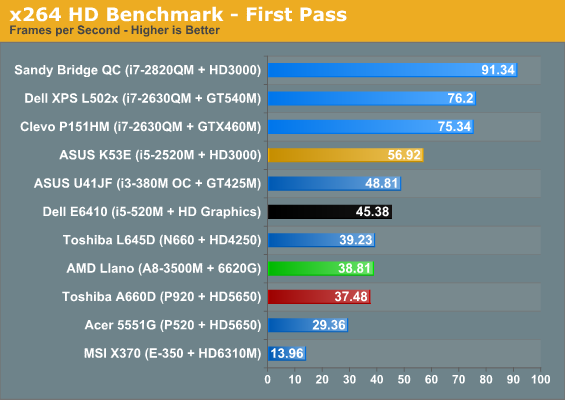
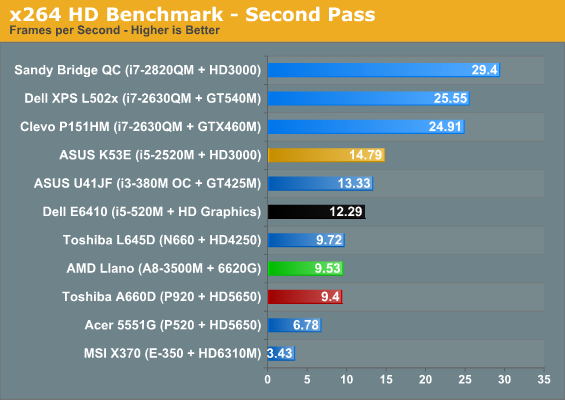
This time we have a more interesting competitor to look at: the Toshiba A660D. AMD says Turbo Core works at speeds of up to 2.4GHz on the A8-3500M, but we have no way of monitoring the actual CPU clocks right now. (CPU-Z if you’re wondering shows a constant 1.5GHz, but AMD says that utility doesn’t currently detect the proper clocks.) When we compare performance results between the Llano notebook and the A660D, we definitely see some differences in performance. Some of that may come from the added L2 cache and other architectural tweaks, but Cinebench R10 in particular shows a healthy 17% performance increase, even with a base clock that’s 7% lower. In the multi-threaded Cinebench result, the lead drops to 10%, which correlates well with how we’d expect Turbo Core to work. PCMark Vantage is still heavily influenced by the storage subsystem, and the storage score of 2950 on the A660D versus 3791 on the Llano suggests the Toshiba HDD is a significant bottleneck.
Looking at other laptops and tests where we’re looking purely at CPU performance, suddenly Llano starts to struggle. The Arrandale i5-520M offers 92% higher single-threaded performance in Cinebench R10 and 48% better single-threaded performance in R11.5; multi-threaded performance also goes to Arrandale, with a 23% lead in R10 and 17% lead in R11.5. x264 also gives Arrandale a decent lead, with i5-520M 17% faster in the first pass and 29% faster in the more intense second pass. The overclocked i3-380M in ASUS’ U41JF tells a similar tale—and both of these laptops are running processors from early last year. When we shift to Sandy Bridge, even without looking at the quad-core parts AMD’s CPU performance is tenuous. The i5-2520M is anywhere from 50 to 150 percent faster depending on which test we look at; even if we toss out the older Cinebench R10 single-threaded result of 150%, R11.5 given the 2520M a 94% lead. In general, then, a moderate dual-core Sandy Bridge i5-series processor looks to be at least 30% faster, so quad-core Llano really only competes with Core i3 and its lower, non-Turbo clocks.
None of the results here are particularly surprising; K10.5 even at 32nm is still largely the same performance. AMD has focused this round up upgrades more on reducing power consumption rather than increasing performance, and that’s a perfectly reasonable approach for a mobile CPU. Most of us probably aren’t doing 3D rendering, CAD/CAM, or unassisted video transcoding on our laptops anyway. It would still be great to see AMD offer up an equivalent to Intel’s Quick Sync; they have the better GPU architecture, but a dedicated decoder like Quick Sync can clearly pay dividends. Outside of that one deficit the reality is that Llano is still plenty fast. Slapping an SSD into Llano will make more of a difference than upgrading an HDD-based Llano laptop to Core i5, so if you’re looking for an inexpensive laptop that can do everything most users need, Llano is very appealing.










177 Comments
View All Comments
JarredWalton - Tuesday, June 14, 2011 - link
The only way to make sure that Intel's current processors aren't at the top of most charts is to leave them out, particularly on notebooks. If we only look at IGP/fGPU, AMD comes out on top of graphics charts, but is that fair to NVIDIA's Optimus technology that allows dynamic switching between IGP and dGPU in a fraction of a second? The overall tone of this article (apart from the CrossFire section) is positive, but still people look at the charts and freak out because we didn't manipulate data to make Llano look even better. It's not bad, but it's certainly not without flaws.kevith - Tuesday, June 14, 2011 - link
Oh too bad.I would like to use a laptop for music production with Nuendo and Win 7.
It actually reqires a little more graphics-musclle than you might think to run an app like Nuendo.
And,up to now, it has not been possible to get both a powerful CPU and GPU in the same machine for the money I have.
So now the fGPU is powerful enough, that's great. But it seems, that the CPU-part of these APU's are too weak.
Øv...
krumme - Tuesday, June 14, 2011 - link
ØhhhJust make sure your computer have 1Gb ram and win xp sp2, Nuendo even runs on single core 2Ghz whatever old shit.
I would save the money and buy a e350.
Heck you could even buy an Atom 510, acording to Anandtech, its just as fast as e350 for the cpu side.
When i think about it. Just do that.
ET - Tuesday, June 14, 2011 - link
As madseven7 commented correctly, this isn't the fastest Llano CPU. There are 45W parts which perform better. They will have less battery life, but a significant increase in core speed. If you're interested in Llano you might want to wait until they get reviewed.JarredWalton - Tuesday, June 14, 2011 - link
I suspect the 45W Llano parts will only have less battery life if you're specifically doing CPU/GPU intensive tasks. At idle, SNB and Llano should both bottom out at similar levels. For example, if you have a 2630QM and a 2820QM doing nothing, they both run at a very low clock and voltage. We'll test any other Llano chips we can get and report our findings, but other factors (BIOS and firmware optimizations) will generally be more important than whether the TDP is 35W or 45W, at least for our particular battery life tests.Shadowmaster625 - Tuesday, June 14, 2011 - link
I dont get the Cinebench single threaded results. An N660 is about the same as a desktop X2 250/255 on that benchmark. Yet this A83500M scores only 61% of what an X2 250 does. That would seem to indicate that it is only running at 1.8GHz during that single threaded test. Why so low with 3 idle cores? It should be running at 2.5GHz and scoring 2500, or just neck and neck with a P520. Turbo is clearly not working anywhere near as well as it should be.krumme - Tuesday, June 14, 2011 - link
Well this is AMD business at work. They are in a constant learning process and have been for the last 40 years.Next time they might consider the following:
1. Dont send some half baked prototypes to the reviewers. Wait fx. 3 more weeks. This is just old Jerry Sanders style.
2. Consider not sending stuff to Anandtech. As anandtech lives from backlinking also, the site needs the new product. And AMD, - and for the sake of the consumers right decisions, can live without 3 similar i7 plus high end discrete gfx, at 1.200 usd at the top of each chart. If AMD dont understand they have other interest than Anandtech - its business for all - they cannot serve their own interest. And its about time they start to earn their own money. They are competing against Otellini not some stupid schoolboy.
JarredWalton - Tuesday, June 14, 2011 - link
Thanks, krumme; always a helpful response. Lenovo has taken this to heart, I'm sure you'll be happy to know, and is not sending any review samples our way. Amazingly, we're still able to survive. And FWIW, if AMD hadn't sent us anything, we'd have had more content earlier through other sources. The only way they can get us to abide by NDAs is by actually working with us.krumme - Tuesday, June 14, 2011 - link
Well thank you Jarred. That was an helpfull answer! that explains a lot.I hope AMD gives you attention and work with you in the future, its in all your readers interest.
That means AMD giving you priority, broad access to the right people and more time to do the reviews.
JarredWalton - Tuesday, June 14, 2011 - link
This is something I discussed with AMD numerous times, and it's one of the reasons we want a utility that will show us true CPU clock speeds in real time. Unfortunately, they don't have anything they're willing to share with us right now. They said they have test units where they can monitor this stuff, but it requires special BIOS hooks and those are not present in our preview samples. In theory, Turbo Core should allow the single-threaded Cinebench result to run up to 60% faster than non-Turbo. Of course, we can't even disable Turbo Core either, so we don't know how much TC is actually helping.P920 is clocked 6.7% higher than A8-3500M, but 3500M has twice the L2 cache and some other enhancements. With 3500M coming in 17% faster than P920, that would suggest that 3500M averages around 1900MHz, but that could mean it runs at 2.4GHz for a bit and then 1.5GHz for a bit, or somewhere in between.
Given the way AMD does Turbo Core (monitoring instruction workloads and their relative power requirements), I think that at least right now, it's not being as aggressive as Intel's Turbo Boost. It feels more like Bloomfield and Arrandale turbo, where you got an extra 2-4 bins, rather than Sandy Bridge where you can get an extra 5-10 bins. Hopefully we'll see refinements with Turbo Core over the coming months and years.